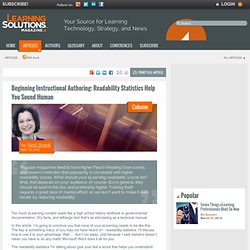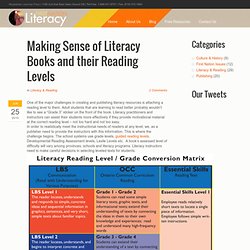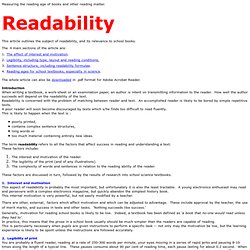

Beginning Instructional Authoring: Readability Statistics Help You Sound Human by Patti Shank. “Popular magazines tend to have higher Flesch Reading Ease scores, and research indicates that popularity is correlated with higher readability scores.

What should your eLearning readability scores be? Well, that depends on your audience, of course. But in general, they should be least in the 50s, and preferably higher. Training itself requires a great deal of mental effort, so we don’t want to make it even harder by reducing readability.” Too much eLearning content reads like a high school history textbook or governmental documentation.
In this article, I’m going to convince you that none of your eLearning needs to be like this. The readability statistics I'm talking about give your text a score that helps you understand the effort it takes your learner to understand your content. There are a number of readability statistics, such as McLaughlin's SMOG, Gunning Fog Index, and Flesch Reading Ease.
Figure 1. Source: Figure 2. Source: Example 2 is much more readable than example 1. Where: The Readability Test Tool. Grass Roots Press. Mockingbird by Kathryn Erskine « Six Trait Gurus. Good Reads - ABC Life Literacy Canada. Making Sense of Literacy Books and their Reading Levels. One of the major challenges in creating and publishing literacy resources is attaching a reading level to them.

Adult students that are learning to read better probably wouldn’t like to see a “Grade 3” sticker on the front of the book. Literacy practitioners and instructors can assist their students more effectively if they provide motivational material at the correct reading level – not too hard and not too easy. In order to realistically meet the instructional needs of readers at any level, we, as a publisher need to provide the instructors with this information. This is where the challenge begins. The school systems use grade levels, guided reading levels, Developmental Reading Assessment levels, Lexile Levels etc. In Ontario, Ningwakwe Learning Press has been using the Literacy and Basic Skills reading levels 1 – 5.
The MTCU funded Gates website – “Goals and Training for Employment Success” states: Ningwakwe Learning Press has developed an Assessment and Evaluation Matrix in order. Weiser Educational. Reading Level Conversion Chart, Leveling Books. Readability and reading ages of school science text-books. Measuring the reading age of books and other reading matter.

This article outlines the subject of readability, and its relevance to school books. The 4 main sections of the article are: 1. The effect of interest and motivation. 2. Legibility, including type, layout and reading conditions. 3. Sentence structure, including readability formulae. 4. The whole article can also be downloaded in .pdf format for Adobe Acrobat Reader. Introduction When writing a textbook, a work-sheet or an examination paper, an author is intent on transmitting information to the reader. Poorly printed, contains complex sentence structures, long words or too much material containing entirely new ideas. The term readability refers to all the factors that affect success in reading and understanding a text. The interest and motivation of the reader. These factors are discussed in turn, followed by the results of research into school science textbooks. AR BookFinder US.